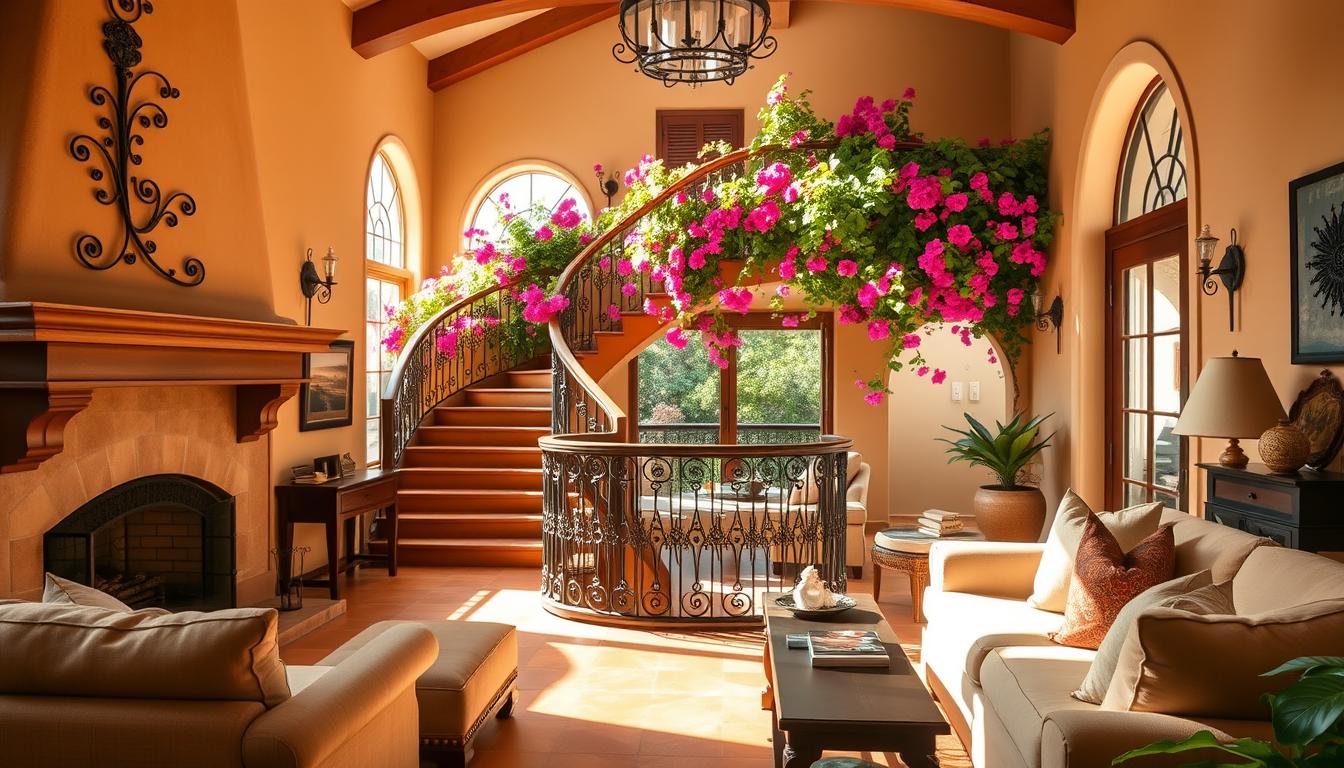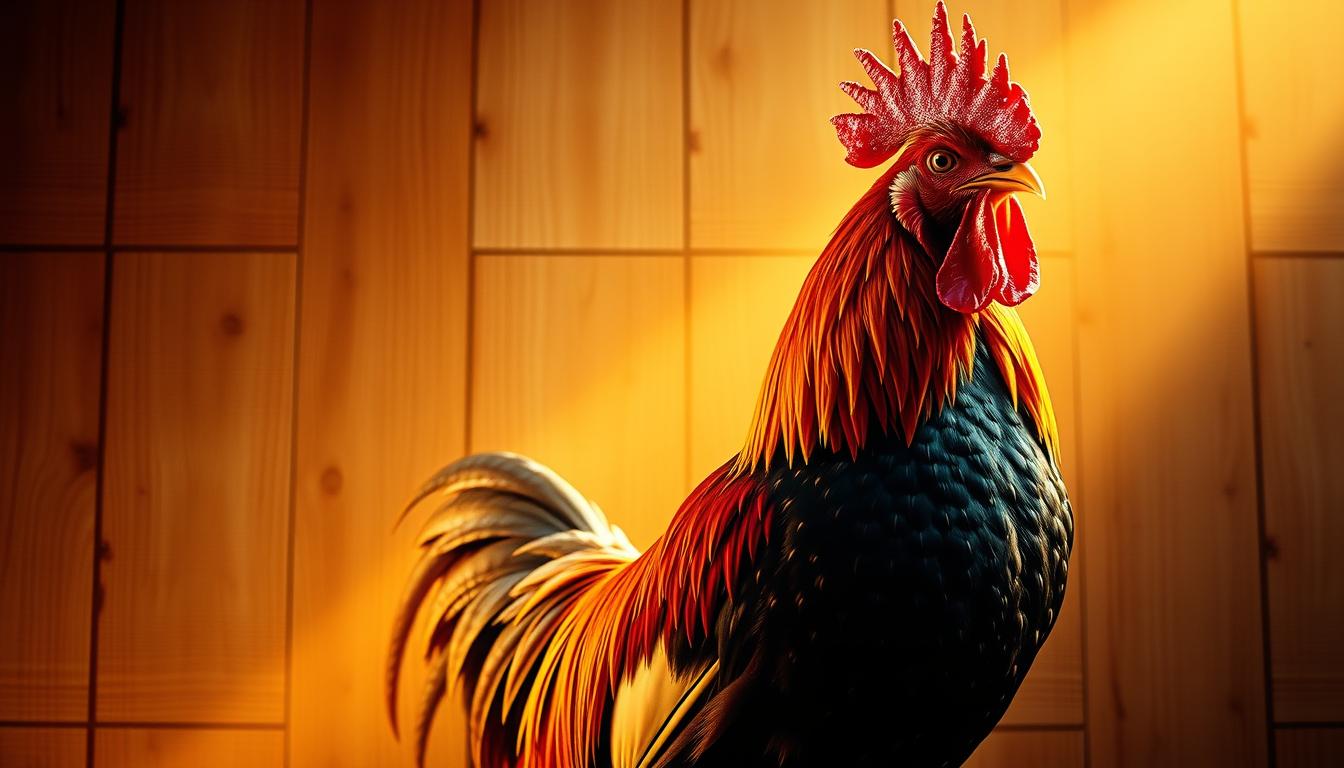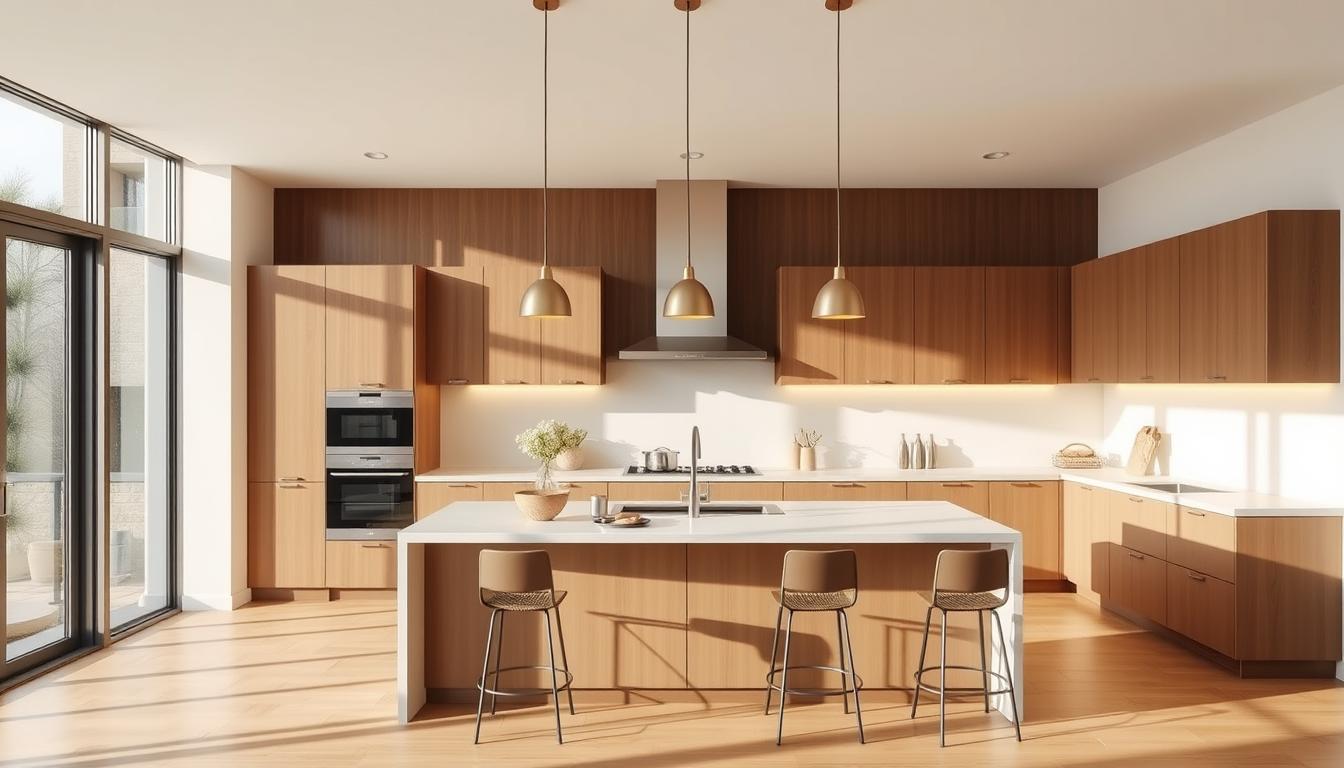Spanish-style homes have been loved for years. They mix old charm with new elegance. The Ralston Architects Team says, “Spanish-style homes and architecture create some of the most timeless house styles on the market.” This shows how Spanish-style design is both versatile and beautiful.
This guide will show you how to make a beautiful spanish style homes interior. We’ll cover traditional features and modern twists. For more ideas, check out modern Spanish-style home interior design ideas. They mix old and new perfectly.
Key Takeaways
- Understanding the timeless appeal of Spanish-style homes
- Identifying key elements of spanish interior design
- Learning how to blend traditional and modern elements
- Discovering the importance of natural materials and textures
- Exploring the role of statement lighting and antiques in Spanish-style design
Understanding Spanish-Style Homes and Their Charm
Spanish-style homes have a timeless charm that’s both elegant and welcoming. They draw from Spanish architecture, which has a rich history. This history combines influences from the Mediterranean to the Americas, as noted by Ralston Architects Team. This mix creates a unique style that’s typical of Spanish-style homes.
Historical Significance of Spanish Architecture
Spanish architecture is deeply rooted in history. It reflects Spain’s complex past and the many cultures that have shaped it. The Moors, Romans, and Gothic styles have all influenced Spanish architecture. This has resulted in a rich design that’s seen in Spanish-style homes.
The use of natural materials like stone, wood, and terracotta is common in Spanish homes. These materials add durability and warmth, connecting the home to nature.
Key Characteristics of Spanish-Style Homes
So, what makes Spanish-style homes special? They often feature arches and curved lines, adding elegance and fluidity. Also, terracotta roof tiles give them a unique look and protect against the weather.
Spanish homes also have ornate detailing and decorative tile work. These add visual interest and depth to the design. By using these features, homeowners can create a beautiful and authentic space.
Key Elements of Spanish-Style Interior Design
Modern Spanish style design mixes old and new to look fresh and updated. Design experts say this mix is key in Spanish-style homes. It aims to make the home warm and welcoming.
Spanish-style homes are known for their open spaces. These spaces make the home feel bigger and more open. Let’s dive into what makes these spaces special.
The Importance of Open Spaces
Open spaces are a big part of Spanish-style design. By using fewer walls and bigger doors, spaces feel connected and big. This openness brings a sense of freedom and makes the home feel more open.
“Open spaces in Spanish homes make moving from one area to another smooth,” design experts say. This creates a unified and coherent feel.
Incorporating Arches and Curves
Arches and curves are also key in Spanish-style design. They add elegance and sophistication. Arches, for example, can frame doors, windows, and room entrances, adding depth and interest.
Curves and arches also soften the home’s look. They balance out solid materials like wood and stone. This mix of curves and solid materials is a hallmark of rustic Spanish home interiors.
By using these elements, homeowners can create a Spanish-style interior that’s both authentic and modern. Whether renovating or designing a new home, understanding these elements is crucial. It helps in making a beautiful and inviting space.
Color Palette for Spanish-Style Interiors
The color palette is key in Spanish-style interior design. It brings warmth and authenticity to your home. We’ll see how the right colors can make your home cozy and welcoming.
Warm, Earthy Tones
Spanish-style homes are known for their warm, earthy tones. These tones create a sense of comfort and history. Colors like terra cotta, ochre, deep reds, and browns are used.
These colors are not just pleasing to the eye. They also help blend indoor and outdoor spaces smoothly.
To add these colors to your home, use terra cotta tiles for flooring. They bring a rustic warmth. Paint walls with soft ochre or beige. Use deep reds and browns for furniture and decor.
Accent Colors in Spanish-Style Homes
Warm, earthy tones are the base of Spanish-style interiors. Accent colors add depth and character. Blues and greens, inspired by Spanish tiles and nature, are often used.
These colors can be seen in decorative tiles, textiles, and artwork. To balance, use accent colors wisely. For example, a bold blue tile can be a statement in your kitchen or bathroom. Green textiles can brighten up your living room.
| Color | Usage | Effect |
|---|---|---|
| Terra Cotta | Flooring, Accent Walls | Warmth, Rustic Feel |
| Ochre | Walls, Decorative Pieces | Soft, Earthy Tone |
| Deep Reds and Browns | Furniture, Accessories | Richness, Cultural Heritage |
| Blues and Greens | Accent Tiles, Textiles, Artwork | Depth, Character |
By mixing warm, earthy tones with the right accent colors, you can create a Spanish-style interior. It will be both authentic and inviting.
Flooring Options in Spanish-Style Homes
The flooring in Spanish-style homes is more than just practical. It’s a key element that captures the essence of this classic style. The right flooring can make your home feel like Spain, creating a cozy and inviting space.
When picking flooring for your Spanish-style home, think about materials that look traditional yet are durable and comfy. Terracotta tiles and hardwood flooring are two top choices that capture the spirit of Spanish architecture.
Using Terracotta Tiles
Terracotta tiles are a hallmark of Spanish architecture, known for their earthy tones and rustic charm. “Terracotta tiles are one of the most prominent features of Spanish architecture,” as they bring warmth and authenticity to any room. Their natural, sun-dried look adds depth and character that’s hard to find elsewhere.
Benefits of Terracotta Tiles:
- Authentic Spanish look
- Durable and long-lasting
- Variety of earthy tones
- Can be sealed for protection
Hardwood Options for Authenticity
Hardwood is a great choice for a more refined and elegant look. Hardwood flooring, in rich, dark tones, adds sophistication and authenticity to Spanish-style interiors. Walnut and oak are favorites for their durability and classic appeal.
| Hardwood Type | Characteristics | Authenticity Level |
|---|---|---|
| Walnut | Dark, rich tones; durable | High |
| Oak | Classic appeal; versatile | High |
| Maple | Light color; resistant to scratches | Medium |
In conclusion, terracotta tiles and hardwood flooring both bring unique benefits to Spanish-style homes. By choosing the right flooring, homeowners can create a warm, inviting space that reflects the charm and elegance of this timeless architectural style.
Furnishing Your Spanish-Style Home
To make your home look like a true Spanish-style home, pick furniture and accessories that show off Spanish architecture’s rich heritage. This style is known for its warm, welcoming feel. It uses traditional materials and skilled craftsmanship to achieve this.
Choosing Authentic Furniture Pieces
Furniture that’s true to Spanish style is key to your home’s character. Look for pieces made from solid woods like walnut or oak. These were favorites in traditional Spanish furniture making.
Wrought iron has been a big part of Spanish architecture for ages. You can find it in furniture or decorations, adding to your home’s Spanish flair.
Choose furniture with detailed carvings or fancy designs. These are common in Spanish-style furniture. Pieces that show the Mudéjar style, with its Moorish touches, can also make your home feel more authentic.
Incorporating Rustic Accessories
Rustic accessories can make your Spanish-style home feel warmer and more unique. Use terracotta pots, wooden crates, or woven baskets for a rustic look. Rustic metalwork, like wrought iron candle holders or lanterns, also fits well with this style.
Adding vintage rugs, embroidered linens, or tapestries can also warm up your space. These items not only show Spain’s cultural heritage but also make your home feel cozy and welcoming.
Importance of Textiles and Fabrics
Textiles and fabrics in Spanish-style homes do more than look good. They make the space feel warm and real. These elements really define the character of the interior.
Choosing the right fabrics is key. Look for materials that show the traditional warmth and richness of Spanish design. Organic textures like woven fibers, leather, and wood are great. They add depth and bring history and culture into your home.
Selecting Appropriate Fabrics
When picking fabrics, think about the look you want. Velvet and silk add luxury, while linen and cotton give a rustic vibe. Remember, the fabrics should also be durable and easy to care for, even in busy areas.
Here’s a look at some popular fabrics for Spanish-style interiors:
| Fabric | Characteristics | Best Use |
|---|---|---|
| Velvet | Luxurious, soft, and rich | Upholstery, drapes |
| Linen | Natural, textured, and breathable | Upholstery, bedding |
| Leather | Durable, rich, and classic | Furniture, accessories |
Textiles that Enhance the Color Palette
Textiles can really make your Spanish-style home’s color scheme pop. Earthy tones like terracotta, sienna, and golden brown are typical. Using textiles in these colors helps tie everything together.
For example, terracotta throw pillows and blankets warm up a room. Golden brown leather furniture adds elegance. The trick is to mix these elements well to match your color scheme.
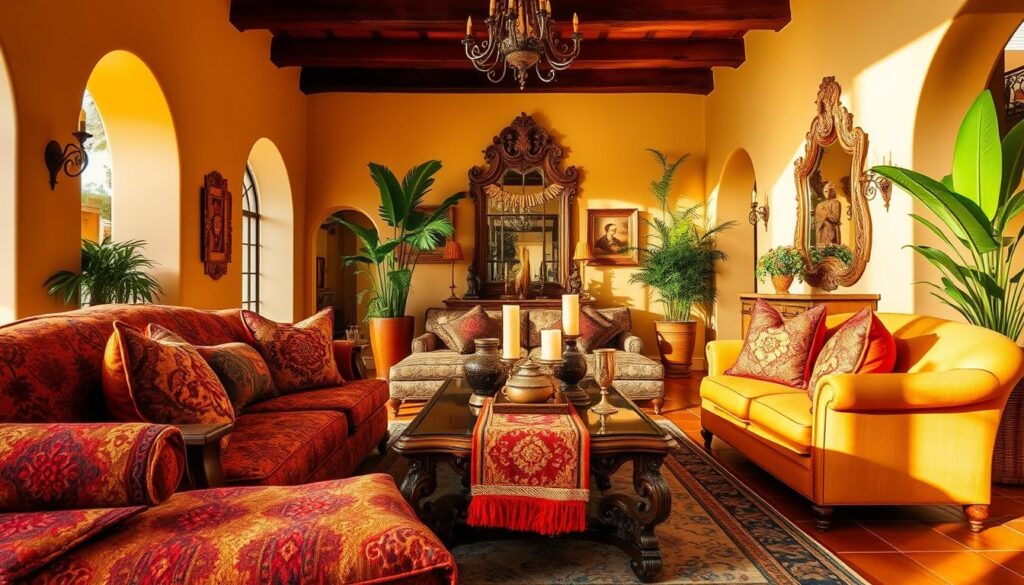
By carefully choosing and using textiles and fabrics, you can make your Spanish-style home even more beautiful and welcoming. It becomes a cozy space for you and your family.
Lighting in Spanish-Style Interiors
Spanish-style interiors are warm and welcoming, thanks to careful lighting design. Lighting highlights the beauty of rustic Spanish homes and Spanish colonial designs.
Types of Lighting Fixtures to Consider
Choosing the right lighting fixtures is key for Spanish-style homes. Wrought iron and metal lanterns bring authenticity and elegance. Pendant lights and chandeliers with detailed designs show off Spanish colonial craftsmanship.
Candelabras and sconces are great for both light and decoration. They often have ornate details and can be made from bronze or copper. This adds to the warm, earthy tones of Spanish-style interiors.
Natural Light and Large Windows
Natural light is essential in Spanish-style homes. Large windows and sliding glass doors let in plenty of light, making spaces bright and airy. It’s best to use minimal window treatments to let in more natural light.
Courtyards and interior patios are also key in Spanish colonial design. They bring in natural light and ventilation. These features make spaces feel open and connected to the outdoors.
| Lighting Fixture | Description | Material |
|---|---|---|
| Wrought Iron Lanterns | Classic, elegant lighting with intricate designs | Wrought Iron |
| Candelabras | Decorative lighting fixtures that add warmth | Bronze, Copper |
| Pendant Lights | Versatile lighting that can be used in various rooms | Metal, Glass |
Outdoor Spaces: Extending Your Interior
Outdoor spaces in Spanish-style homes blend with the inside, creating a smooth transition. This is a key feature of traditional Spanish decorating. It makes the lines between inside and outside fade away.
Spanish homes often have central courtyards or patios. These areas are peaceful and extend the living space. They offer a quiet escape and a place to relax.
Designing Courtyards and Patios
Designing courtyards and patios needs careful thought. Terracotta tiles, ornate fountains, and lush greenery add charm. Warm, earthy tones help tie the outdoor space to the home’s interior.
In modern Spanish interiors, courtyards and patios get a modern twist. They now feature sleek furniture, ambient lighting, and new water features. This keeps the traditional feel while adding a modern touch.
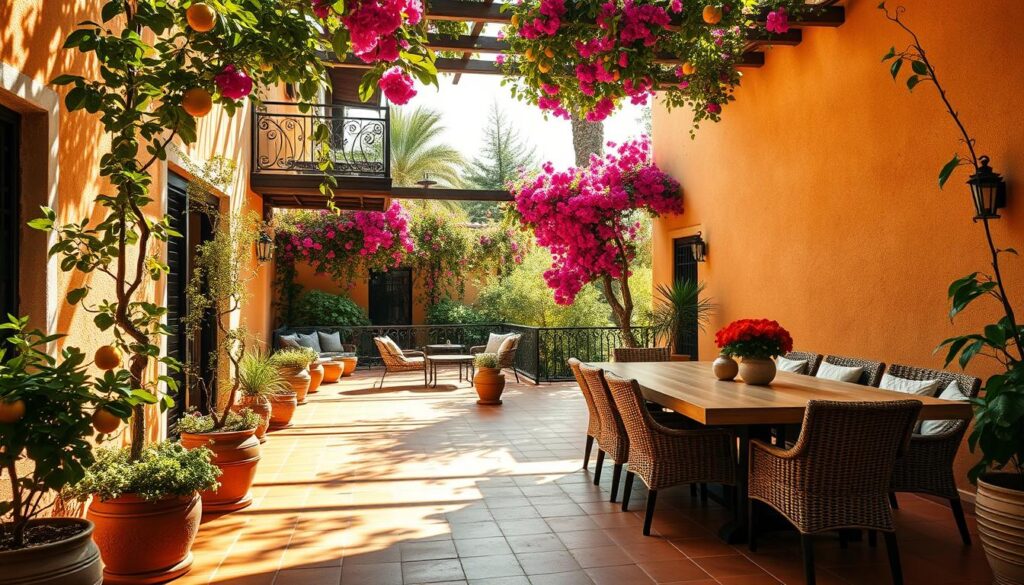
Importance of Landscaping
Landscaping is key in making outdoor spaces beautiful. The right plants and flowers set the mood. Drought-resistant plants and fragrant flowers like jasmine and lavender are favorites. They match the Spanish style perfectly.
| Landscaping Element | Description | Benefits |
|---|---|---|
| Drought-resistant plants | Plants that require minimal watering | Water conservation, low maintenance |
| Fragrant flowers | Flowers with a pleasant fragrance | Enhances ambiance, attracts pollinators |
| Ornate fountains | Decorative water features | Aesthetic appeal, soothing sound |
With careful design, courtyards, patios, and landscaping, homes become more inviting. They show off the beauty of Spanish-style homes and offer a peaceful spot to relax.
Incorporating Art and Decor
Spanish-style interiors are stunning, thanks to their architecture and the art and decor that fill them. To make your home feel truly Spanish, add elements that show off Spain’s rich culture.
Selecting Spanish-Influenced Artwork
Choosing artwork for your Spanish-style home is key. Look for pieces that show Spanish art and culture. This could be art by Spanish artists or items that highlight Spain’s history and traditions. Adding traditional Spanish art like ceramics, textiles, and metalwork makes your space more authentic.
Some great choices for Spanish-inspired artwork include:
- Paintings by Spanish masters, such as El Greco or Velázquez
- Tapestries and textiles that show traditional Spanish designs
- Ceramic pieces, like vases or tiles, that showcase Spanish craftsmanship
Integrating Cultural Decor Elements
Decor elements that show Spanish culture are also important. Antiques connect us to the past and add history and tradition to your home.
Here are some ways to add cultural decor:
| Decor Element | Description |
|---|---|
| Antique furniture | Pieces that show traditional Spanish craftsmanship, like intricately carved wooden furniture |
| Cultural artifacts | Items that reflect Spanish culture, like flamenco-inspired decor or traditional Spanish clothing |
By adding these elements, you can make your home beautiful and full of cultural heritage.
Sustainable Practices in Spanish Home Design
Adding sustainable practices to Spanish home design makes them better for the environment. It also keeps their charm. Looking into Mediterranean interior decor shows that green design is key, not just a trend.
Spanish homes are famous for their cozy feel. Using eco-friendly materials can make them even greener. For example, reclaimed wood adds beauty and tells a story of saving the planet.
Utilizing Eco-Friendly Materials
Choosing the right materials is vital for green design. Using local materials cuts down on emissions and helps the local economy. Terracotta tiles, common in Spanish homes, can be made locally, lowering carbon emissions.
| Eco-Friendly Material | Benefits | Application in Spanish-Style Homes |
|---|---|---|
| Reclaimed Wood | Reduces waste, unique character | Flooring, furniture |
| Terracotta Tiles | Locally sourced, durable | Flooring, walls |
| Sustainable Hardwoods | Renewable resource, long-lasting | Furniture, trim |
Energy Efficiency in Spanish-Style Homes
Energy efficiency is crucial in Spanish home design. Using energy-saving windows is a big help. These windows keep the house cool in summer and warm in winter. They also let in natural light, cutting down on the need for electric lights.
Ralston Architects Team says that “energy-efficient windows” and “reclaimed wood” are key for green Spanish homes.
By using eco-friendly materials and improving energy use, we can make Spanish homes beautiful and green.
Final Touches for Spanish-Style Homes
As we finish our Spanish-style home, the final touches are key. They make the space warm and welcoming. We mix old traditions with new styles for a fresh look.
Adding a Personal Touch
Personalizing your home means adding pieces that show who you are. Think about adding modern touches like colorful textiles or contemporary art. This mix of old and new is unique.
Blending Tradition with Modernity
To keep things real while making them new, we use old Spanish touches like reclaimed wood or terracotta tiles. We pair these with modern appliances. This mix makes your home stand out.
By carefully combining old and new, we make a Spanish-style home that’s both stunning and practical.

